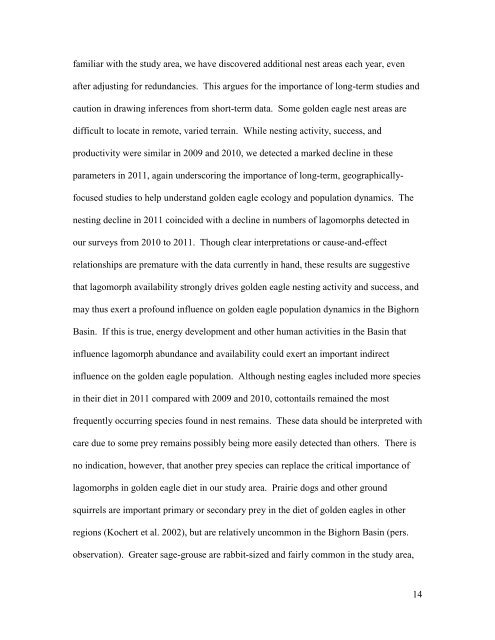BLM WY Golden Eagle Research and Monitoring - Buffalo Bill ...
BLM WY Golden Eagle Research and Monitoring - Buffalo Bill ...
BLM WY Golden Eagle Research and Monitoring - Buffalo Bill ...
You also want an ePaper? Increase the reach of your titles
YUMPU automatically turns print PDFs into web optimized ePapers that Google loves.
familiar with the study area, we have discovered additional nest areas each year, even<br />
after adjusting for redundancies. This argues for the importance of long-term studies <strong>and</strong><br />
caution in drawing inferences from short-term data. Some golden eagle nest areas are<br />
difficult to locate in remote, varied terrain. While nesting activity, success, <strong>and</strong><br />
productivity were similar in 2009 <strong>and</strong> 2010, we detected a marked decline in these<br />
parameters in 2011, again underscoring the importance of long-term, geographicallyfocused<br />
studies to help underst<strong>and</strong> golden eagle ecology <strong>and</strong> population dynamics. The<br />
nesting decline in 2011 coincided with a decline in numbers of lagomorphs detected in<br />
our surveys from 2010 to 2011. Though clear interpretations or cause-<strong>and</strong>-effect<br />
relationships are premature with the data currently in h<strong>and</strong>, these results are suggestive<br />
that lagomorph availability strongly drives golden eagle nesting activity <strong>and</strong> success, <strong>and</strong><br />
may thus exert a profound influence on golden eagle population dynamics in the Bighorn<br />
Basin. If this is true, energy development <strong>and</strong> other human activities in the Basin that<br />
influence lagomorph abundance <strong>and</strong> availability could exert an important indirect<br />
influence on the golden eagle population. Although nesting eagles included more species<br />
in their diet in 2011 compared with 2009 <strong>and</strong> 2010, cottontails remained the most<br />
frequently occurring species found in nest remains. These data should be interpreted with<br />
care due to some prey remains possibly being more easily detected than others. There is<br />
no indication, however, that another prey species can replace the critical importance of<br />
lagomorphs in golden eagle diet in our study area. Prairie dogs <strong>and</strong> other ground<br />
squirrels are important primary or secondary prey in the diet of golden eagles in other<br />
regions (Kochert et al. 2002), but are relatively uncommon in the Bighorn Basin (pers.<br />
observation). Greater sage-grouse are rabbit-sized <strong>and</strong> fairly common in the study area,<br />
14






